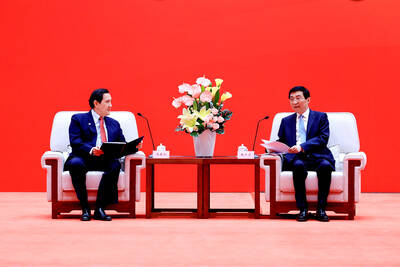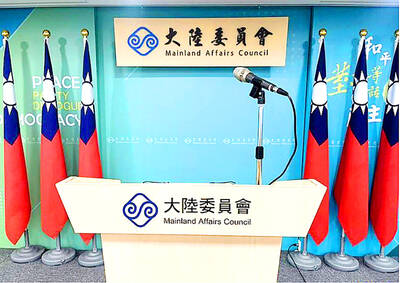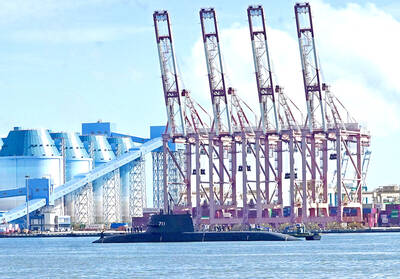Former central banker Mark Carney was sworn in as Canada’s new prime minister on Friday, and would try to steer his country through a trade war brought by US President Donald Trump, annexation threats and an expected federal election.
Carney, 59, replaces Justin Trudeau, who announced his resignation as prime minister in January, but remained in power until the Liberal Party elected a new leader. Carney is widely expected to trigger a general election in the coming days or weeks.
“We will never, ever, in any way shape or form, be part of the United States. America is not Canada,” Carney said. “We are very fundamentally a different country.”

Photo: AFP
The governing Liberal Party had appeared poised for a historic election defeat this year until Trump declared economic war and repeatedly has said Canada should become the 51st US state. Now the party and its new leader could come out on top.
Carney has said he is ready to meet with Trump if he shows respect for Canadian sovereignty.
He said he does not plan to visit Washington at the moment, but hopes to have a phone call with the US president soon.
“The president is a successful businessman and deal maker. We’re his largest client in so many industries,” Carney said. “Clients expect respect and working together in a proper commercial way.”
Carney navigated crises when he was the head of the Bank of Canada during the 2008 financial crisis, and then in 2013 when he became the first non-citizen to run the Bank of England — helping to manage the worst impacts of Brexit in the UK.
Carney, a former Goldman Sachs executive with no experience in politics, becomes Canada’s 24th prime minister. He said protecting Canadian workers and their families in the face of unjustified trade actions and growing the economy would be his top priorities.
Carney said he would travel to Europe to visit French President Emmanuel Macron and British Prime Minister Keir Starmer in the coming days. He received invitations from both.
“We must diversify our trade partners and strengthen our security in so doing,” Carney said.
Trump put 25 percent tariffs on Canada’s steel and aluminum, and is threatening sweeping tariffs on all Canadian products from April 2. He has threatened economic coercion in his annexation threats and suggested the border is a fictional line.
Carney called the idea “crazy.”
The US trade war and Trump’s talk of making Canada the 51st US state have infuriated Canadians, who are booing the US anthem at NHL and NBA games. Some are canceling trips south of the border, and many are avoiding buying US goods when they can.
Carney said he worked with Trump at G7 and G20 summits during Trump’s first presidency.
“We share some experiences. I have been in the private sector. I have worked in the real-estate sector. I have done large transactions,” Carney said. “We will both be looking out for our countries, but he knows, and I know from long experience, that we can find mutual solutions that win for both.”

CHIP WAR: The new restrictions are expected to cut off China’s access to Taiwan’s technologies, materials and equipment essential to building AI semiconductors Taiwan has blacklisted Huawei Technologies Co (華為) and Semiconductor Manufacturing International Corp (SMIC, 中芯), dealing another major blow to the two companies spearheading China’s efforts to develop cutting-edge artificial intelligence (AI) chip technologies. The Ministry of Economic Affairs’ International Trade Administration has included Huawei, SMIC and several of their subsidiaries in an update of its so-called strategic high-tech commodities entity list, the latest version on its Web site showed on Saturday. It did not publicly announce the change. Other entities on the list include organizations such as the Taliban and al-Qaeda, as well as companies in China, Iran and elsewhere. Local companies need

CRITICISM: It is generally accepted that the Straits Forum is a CCP ‘united front’ platform, and anyone attending should maintain Taiwan’s dignity, the council said The Mainland Affairs Council (MAC) yesterday said it deeply regrets that former president Ma Ying-jeou (馬英九) echoed the Chinese Communist Party’s (CCP) “one China” principle and “united front” tactics by telling the Straits Forum that Taiwanese yearn for both sides of the Taiwan Strait to move toward “peace” and “integration.” The 17th annual Straits Forum yesterday opened in Xiamen, China, and while the Chinese Nationalist Party’s (KMT) local government heads were absent for the first time in 17 years, Ma attended the forum as “former KMT chairperson” and met with Chinese People’s Political Consultative Conference Chairman Wang Huning (王滬寧). Wang

CROSS-STRAIT: The MAC said it barred the Chinese officials from attending an event, because they failed to provide guarantees that Taiwan would be treated with respect The Mainland Affairs Council (MAC) on Friday night defended its decision to bar Chinese officials and tourism representatives from attending a tourism event in Taipei next month, citing the unsafe conditions for Taiwanese in China. The Taipei International Summer Travel Expo, organized by the Taiwan Tourism Exchange Association, is to run from July 18 to 21. China’s Taiwan Affairs Office spokeswoman Zhu Fenglian (朱鳳蓮) on Friday said that representatives from China’s travel industry were excluded from the expo. The Democratic Progressive Party government is obstructing cross-strait tourism exchange in a vain attempt to ignore the mainstream support for peaceful development

DEFENSE: The US would assist Taiwan in developing a new command and control system, and it would be based on the US-made Link-22, a senior official said The Ministry of National Defense is to propose a special budget to replace the military’s currently fielded command and control system, bolster defensive resilience and acquire more attack drones, a senior defense official said yesterday. The budget would be presented to the legislature in August, the source said on condition of anonymity. Taiwan’s decade-old Syun An (迅安, “Swift Security”) command and control system is a derivative of Lockheed Martin’s Link-16 developed under Washington’s auspices, they said. The Syun An system is difficult to operate, increasingly obsolete and has unresolved problems related to integrating disparate tactical data across the three branches of the military,